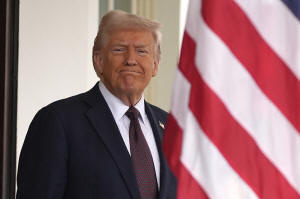Trump plans tariffs on Mexico and Canada for Tuesday, while doubling
existing 10% tariffs on China
[February 28, 2025] By
JOSH BOAK and FABIOLA SANCHEZ
WASHINGTON (AP) — President Donald Trump plans to impose tariffs on
Canada and Mexico starting Tuesday, in addition to doubling the 10%
universal tariff charged on imports from China.
In a Truth Social post Thursday, Trump said illicit drugs such as
fentanyl are being smuggled into the United States at “unacceptable
levels" and that import taxes would force other countries to crack down
on the trafficking.
“We cannot allow this scourge to continue to harm the USA, and
therefore, until it stops, or is seriously limited, the proposed TARIFFS
scheduled to go into effect on MARCH FOURTH will, indeed, go into
effect, as scheduled,” the Republican president wrote. “China will
likewise be charged an additional 10% Tariff on that date.”
The prospect of escalating tariffs has already thrown the global economy
into turmoil, with consumers expressing fears about inflation worsening
and the auto sector and other domestic manufacturers suffering if Trump
raises import taxes. But Trump has also at times engaged in aggressive
posturing only to give last-minute reprieves, previously agreeing to a
30-day suspension of the Canada and Mexico tariffs that were initially
supposed to start in February.

The threat of tariffs frightened the stock market with the S&P 500 index
falling 1.6% on Thursday. The S&P 500 is now just 1.4% higher than it
was after Trump won the election in November, giving up almost all of
the gains that the president once cited as evidence of an economic
revival.
Asked Thursday about the fact that tariffs are largely paid for
consumers and importing companies, Trump dismissed any concerns by
saying: “It's a myth.” It's possible for a stronger U.S. dollar to
offset some of the costs of tariffs, but Trump's statement goes against
most economic modeling given the breadth of his planned taxes.
Trump intends to put 25% tariffs on imports from Mexico and Canada, with
a lower 10% tax on Canadian energy products such as oil and electricity.
The move, ostensibly about drug trafficking and immigration, led Mexico
and Canada to respond by emphasizing their existing efforts to address
these issues. Canada created a fentanyl czar, and Mexico sent 10,000
members of its National Guard to its border with the United States.
Mexican President Claudia Sheinbaum said Thursday that she hoped to
speak with Trump after the Cabinet-level meetings occurring in
Washington this week. Mexico’s Foreign Affairs Secretary Juan Ramón de
la Fuente was scheduled to meet with Secretary of State Marco Rubio on
Thursday afternoon.
Trump, “as you know, has his way of communicating,” Sheinbaum said. But
she said that her government would stay “cool-headed” and optimistic
about an agreement coming together to avoid the tariffs.
“I hope we are able to reach an agreement and on March 4 we can announce
something else,” she said.
She said Mexico’s security chiefs were discussing intelligence sharing
with their American counterparts that would allow for important arrests
in the U.S. On the economic front, she said Mexico’s goal is to protect
the free trade pact that was negotiated during the first Trump
administration between Mexico and the United States. That 2020 deal,
which included Canada, was an update of the North American Free Trade
Agreement from 1994.
Canadian Prime Minister Justin Trudeau said his country has invested
more than 1 billion Canadian dollars to improve border security, adding
that his government's ministers and officials are also in Washington
this week.
“There is no emergency for the United States at the border with Canada
when it comes to fentanyl, and that is exactly what we are demonstrating
at this time,” Trudeau said in Montreal. “If the United States goes
ahead and imposes tariffs, we already shared the details of our plan. We
have $30 billion worth of U.S. products that will be subject to tariffs.
And $125 billion of tariffs that will be applied three weeks later. But
we don’t want to be in that position.”

[to top of second column] |

President Donald Trump stands before British Prime Minister Keir
Starmer arrives at the White House, Thursday, Feb. 27, 2025, in
Washington. (AP Photo/Evan Vucci)
 Trump did impose a 10% tariff on
China for its role in the manufacturing of chemicals used to make
fentanyl, and that tax would now be doubled, according to his social
media post.
On Thursday, China’s Commerce Minister Wang Wentao
wrote to Jamieson Greer, the newly confirmed U.S. trade
representative, that differences on trade should be resolved through
dialogues and negotiations.
The 25% tariffs on Mexico and Canada would amount to a total tax
increase on the U.S. public of somewhere between $120 billion to
$225 billion annually, according to Jacob Jensen, a trade policy
analyst at the American Action Forum, a center-right think tank. The
additional China tariffs could cost consumers up to $25 billion.
The potential for higher prices and slower growth could create
political blowback for Trump, who promised voters in last year's
presidential election that he could quickly lower the inflation
rate, which jumped during Democratic President Joe Biden's term. But
Trump also campaigned on imposing broad tariffs, which he plans to
launch on April 2 by resetting them to match the taxes that he
determines are charged by other countries on American goods.
“The April Second Reciprocal Tariff date will remain in full force
and effect,” Trump said as part of his new social media post.
In an interview with News Nation, Kevin Hassett, the director of the
White House National Economic Council, said progress by Mexico and
Canada on fentanyl “was not as impressive as the president had
hoped.” There are significant differences between Canada and Mexico
on the scale of drug smuggling. U.S. customs agents seized 43 pounds
(19.5 kilograms) of fentanyl at the Canadian border during the last
budget year, compared with 21,100 pounds (9,570 kilograms) at the
Mexican border.
Hassett stressed that the reciprocal tariffs would be in addition to
the ones being placed on Canada and Mexico.

Trump indicated Wednesday that European countries would also face a
25% tariff as part of his reciprocal tariffs. He also wants separate
tariffs on autos, computer chips and pharmaceutical drugs that would
be levied in addition to the reciprocal tariffs.
The president already announced that he's removing the exemptions on
his 2018 steel and aluminum tariffs, in addition to planning taxes
on copper imports.
The prospect of a broader trade conflict should other nations follow
through with their own retaliatory tariffs is already spooking U.S.
consumers, potentially undermining Trump's promise to unleash
stronger economic growth.
The Conference Board reported on Tuesday that its consumer
confidence index had dropped 7 points to a reading of 98.3. It was
the largest monthly decline since August 2021, when inflationary
pressures began to reverberate across the United States as the
economy recovered from the coronavirus pandemic. Average 12-month
inflation expectations jumped from 5.2% to 6% in February, the
Conference Board noted.
“There was a sharp increase in the mentions of trade and tariffs,
back to a level unseen since 2019,” said Stephanie Guichard, a
senior economist at the Conference Board. "Most notably, comments on
the current administration and its policies dominated the
responses.”
___
Associated Press writers Didi Tang and Rob Gillies contributed to
this report. Sanchez reported from Mexico City.
All contents © copyright 2025 Associated Press. All rights reserved |